Black Narcissus, 1947, directed by Michael Powell and Emeric Pressburger, screenplay by Michael Powell and Emeric Pressburger, from the novel by Rumer Godden.
Cinema's a multidisciplinary medium. In a perfect movie, all of its various elements would work together toward a unified goal: writing, acting, cinematography, editing, score, and so on. But one can't have everything; even Citizen Kane has its Achilles' heel.1 Black Narcissus is a cinematographer's movie, a director's movie, an editor's movie, a composer's movie, and an actor's movie. It's got eye-poppingly beautiful Technicolor, and at least one unforgettable performance. On the other hand, the film's politics are cringeworthy, and the structure is truly bizarre: for one hour and ninteteen minutes, it's a travelogue/drama, and then it suddenly becomes a German expressionist horror film. It's absolutely essential viewing and an astonishing technical achievement. But a lot of it is pretty hard to watch.
Here's the premise: Deborah Kerr plays Sister Clodagh, one of the whitest, palest nuns in an exceptionally white and pale order. As the movie opens, she is appointed the youngest, whitest, and palest Mother Superior in the history of the order, and charged with establishing a school and hospital in the Himalayas. I'm not exaggerating how monochromatic Clodagh and her order are—the actresses wore flesh-colored lipstick so their lips wouldn't have too much color:
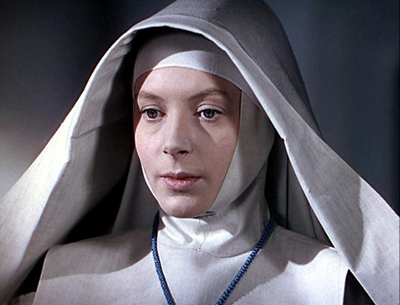
The location for the hospital and school has already been decided: a local general has donated the Palace of Mopu, which looks pretty innocuous when it's just a matte painting:

Inside, however, the murals and paintings give a hint of the palace's original function: living quarters for an older general's harem. It looks to have been a stately pleasure dome right out of Coleridge's most vivid opium dreams:


It's not the first time the general's tried to get a religious order to class the joint up; we're told that an order of monks made a go of it but only lasted a few months. The palace comes complete with a supremely unhelpful housekeeper who pines for the old days (May Hallet, looking more Native American than Indian, frankly; maybe there was a mixup in the costume department):

Security, general handiwork, and leering sexual innuendo are to be provided by British Agent Mr. Dean, played by David Farrar.
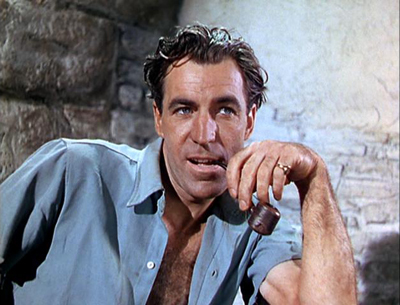
If you're thinking this might be a bad place for a nunnery, you're absolutely right. If you're also thinking Edward Said would have a field day with this movie, you win the Order of the British Empire. So let's run through it: Said's basic critique of Western depictions of the East was that Westerners infantilized, feminized, and eroticized the East to justify a system of colonial oppression and explotation. Black Narcissus soft-pedals the oppression part of the equation, but it's sure got the rest of it. Infantilization? Well, Powell and Pressburger start out with footage that could be from an Encyclopaedia Britannica 16mm film—happy native peasants, working away:
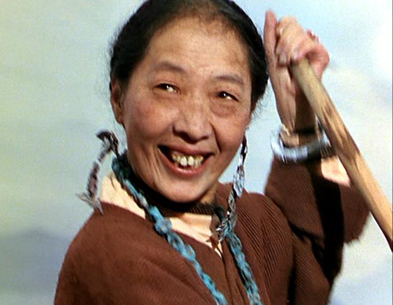
The first time the nuns actually meet the natives, they wow them with a water-to-wine trick that wouldn't play at a five-year-old's birthday party:
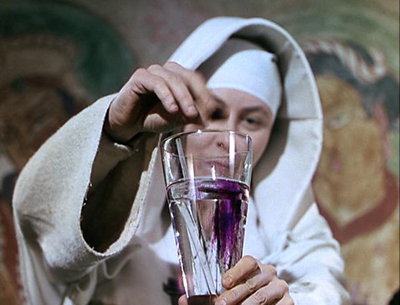
And the dialogue makes this explicit; as Mr. Dean puts it:
Well, you must remember, they're primitive people. Like children. Unreasonable children.
That's infantilization. Next on the checklist is feminizing and debasing Eastern masculinity. And no one else in the history of cinema could play a preening man-child like Sabu, who appears here as a self-absorbed general with all the mental acuity of a precocious first-grader. A picture is worth a thousand words:
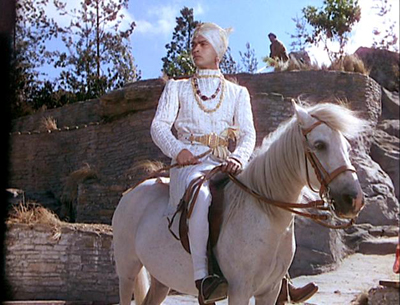
And the film's title refers to a perfume that Sabu's character wears. So there's your feminized masculinity. Last on the list: treating the East as the locus of eroticized, silenced Otherness. Well, how do you feel about Jean Simmons in brownface, eating a papaya?
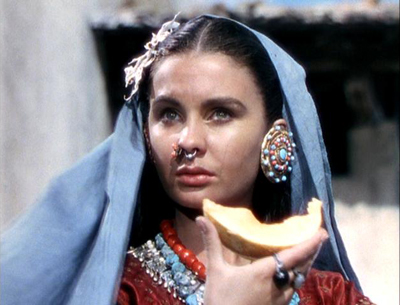
She doesn't have a single line in the entire movie, except when she screams in pain as she's whipped, she's sent to the nunnery because she won't stop trying to seduce Mr. Dean, and you can get a sense of the sexual politics around her character from this shot:
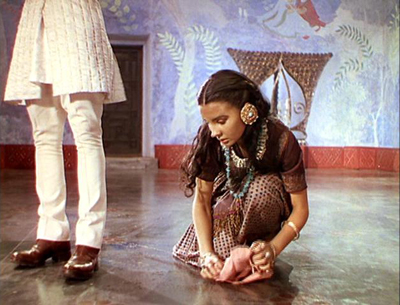
That's Sabu she's crouching in front of; hardly the epitome of masculinity himself. So there were plenty of times in Black Narcissus that I found myself cringing. And yet there are moments when it seems that Powell and Pressburger are in on the sick Colonialist joke. Here's one of the local children helping the nuns give an English lesson:
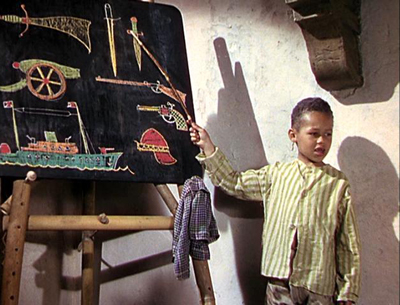
The class repeats after him as he teaches them the words "cannon," "warship," "bayonet," "dagger," and "gun." That's a joke that doesn't seem to be in the novel (at least if Google Books is to be believed). And this is a film that ultimately sees the nun's attempts to civilize the natives as a doomed enterprise. So it's not a classic Colonialist film, like, say, Gunga Din. It's pessimistic about the West's ability to impose order on the East.
Of course, whether you think Western rationalism will defeat Eastern superstition and sensuality or not, as soon as you frame things that way you've given up the game. And Black Narcissus isn't shy about condescending to the East; it's not exactly flattering to decide that the local culture is so hopeless and corrosive that it will destroy any Westerners who try to engage with it.
So why has the movie endured? The cinematography certainly doesn't hurt—this is the most beautifully photographed Technicolor film I've ever seen. But I think most of the film's reputation can be credited to the last act, even though that section represents a dramatic shift in tone.
Over the course of the film, there's a very slow increase in tension between Sister Clodagh and Sister Ruth, mostly caused by sexual jealousy and a mutual attraction to Mr. Dean. With twenty minutes left in the movie, that tension goes completely off the rails, and Powell and Pressburger are suddenly directing a horror film. Despite any problems I might have with the tactic of using India as a blank slate to project the psychosexual conflict between two Western women, the conflict itself is pretty compelling, because of a combination of Kathleen Byron's over-the-top performance and Jack Cardiff's cinematography. To give you some idea, here's Sister Ruth's descent into psychosexual madness in photos:

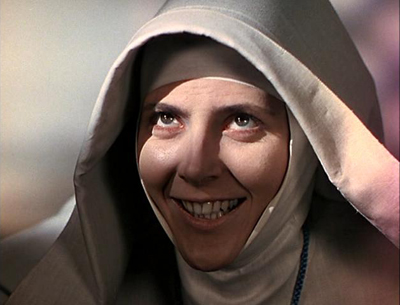



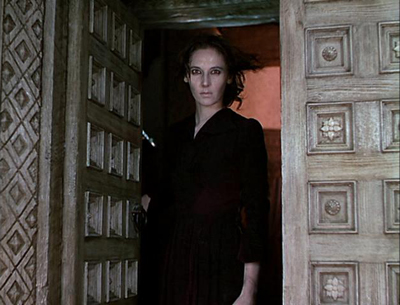
We can stand around and argue all day about whether or not it's a good idea to present female desire as something akin to demonic posession, but it's still unforgettable.2 For those twenty minutes, Black Narcissus is a master class in horror filmmaking.
Unfortunately, Kathleen Byron can't keep stalking around the frame forever, and at the end we're left with a strange mixture: a technically brilliant film that has something more than a little bit rotten at its core. Dave Kehr sees the final shots of the nuns leaving as the rains break as almost a moment of valedictory realism: a farewell to the Raj. I think that analysis misses a rather large point: the nunnery may have been a disaster, but Mr. Dean isn't going anywhere. Just because you can't civilize them doesn't mean they can't pick your tea.
Randoms
- Black Narcissus opened in the UK in May of 1947; it made its way to New York on Wednesday, the 13th of August. That Thursday and Friday, Pakistan and India became independent nations. So this may have been the last film about the British Empire released before it started collapsing in earnest.
- For the record, since I've kind of held Gunga Din up as the worst Colonialist film, I should note that whenever Sam Jaffe is off screen, I love it, warts and all. Like Black Narcissus, the good things about it are so good that they almost make up for the terrible parts. By the way, ever wonder why they cast Sam Jaffe in brownface to play the eponymous water-bearer? Sabu wasn't available. No, I'm not kidding—he really was the go-to guy for Indian stereotypes.
- The DVD includes an excerpt from Painting with Light, a documentary about Jack Cardiff's cinematography. It contains a lot of interesting information about the early days of Technicolor. Here's Cardiff in front of a three-strip Technicolor camera (note the extra wide film magazine: it would hold three reels in parallel).
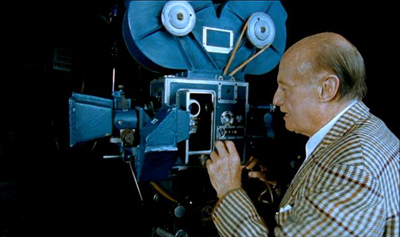
- That's a manageable size for a camera. But here's what the camera looked like when encased in the sound-damping equipment necessary to muffle the noise it made on set:
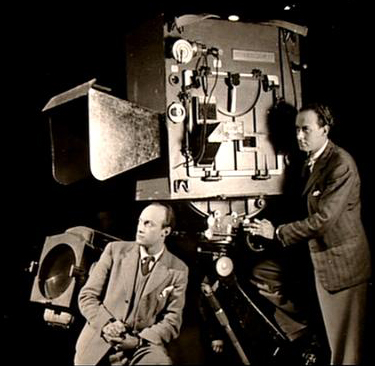
- It's positively cartoonish.
- For reasons that aren't entirely clear, Painting with Light also includes some color footage of the 110/5 interchange, which was replaced a long time ago with a giant stack interchange.
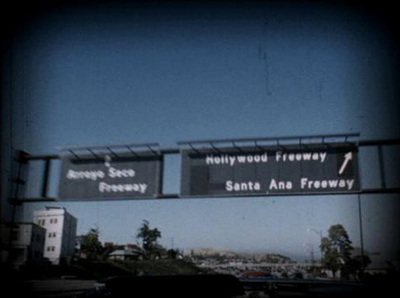
- The film's backdrops of the Himalayas were created from giant blow-ups of black and white photographs, which the art department colored by hand. The matte paintings are exceptionally good; here's one of the best.

- I only knew Jean Simmons from Great Expectations and Hamlet. It's unfortunate that the first time I saw her in color, she was in brownface. But I had no idea how lovely her eyes were.

- Scorsese has nothing but praise for Cardiff's cinematography, for obvious reasons. Here's a shot he singled out for special praise, because of the light on the water. It's from a flashback to Sister Clodagh's civillian life.
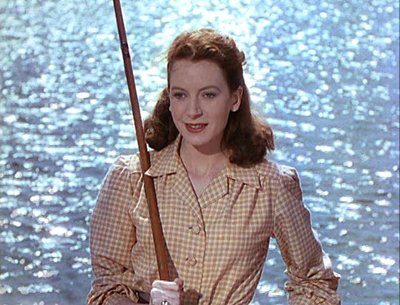
- I certainly agree that the water looks amazing. I also think this shot demonstrates just how perverse it is to cast Deborah Kerr in a Technicolor masterpiece and then hide her hair under a wimple for most of the movie.
- David Farrar's performance as Mr. Dean is pitch-perfect: he's charming, cynical, overtly sexual, and completely corrupt. I carefully chose the still I used of him in the main essay to highlight the things that are great about his performance. Now, the things that are not so great: his wardrobe and his pony.
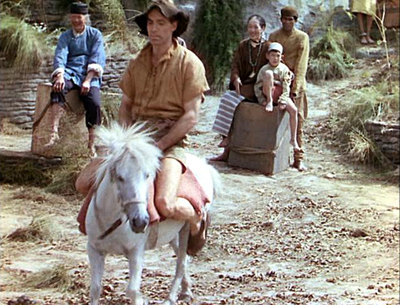
- So let's end with this cautionary photograph from the Journal of Poorly-Explained Haberdashery:

- People of the subcontinent, meet your ruler!
1It's Joseph Cotton's brief turn as "Crazy Ol' Grandpa Leland" in the nursing home scene.
2In our enlightened age, no one would make a movie with a character like Sabu's childlike general. But we keep churning out the Sister Ruths. It's lucrative.


34 comments:
I've been looking forward to this review for a while, as Black Narcissus is easily among my top 50 films of all time. Seeing those great stills of Kathleen Byron makes me want to see it again. I also think you're finally moving into a strong streak in the collection with more Powell/Pressburger, Sirk and L'Avventura coming up.
Despite my unbridled enthusiasm for this film (which ranked #4 in the Spectator's recent top 50 films of all time ranking), I can't really disagree with any of your criticisms. Somehow, these flaws just add to the film's charm for me, and seem forgivable because no claim of cultural superiority is made. On the contrary, the sexually repressed nature of "Western Civilization" is depicted as inevitably leading to psychosis. The natives are much more in touch with their humanity, and are better off for it. As a Jewish American I have no problem getting enjoyment out of The Merchant of Venice and Oliver Twist; in comparison, the racism on display here seems little more than a mild anachronism.
I've always thought this was a HUGE unheralded influence on Kubrick's The Shining.
Especially when you consider that at one point, Kubrick and his co-writer, Diane Johnson, were considering having WENDY, Shelley Duvall's character, go crazy and become a "terrifying, raving madwoman", to qoute Johnson.
Hmmm.....
Mark,
I have such mixed feelings about this movie. If it weren't so great in every other aspect, I wouldn't have been as bothered by its politics. There are so many small moments of brilliance that I didn't even talk about: that weird shot panning up from Sister Clodagh's pencil up to Sister Ruth's crazed grin, or the greens in the hunting sequence in Ireland, or the way the camera tracks around the convent in the opening shots. It wouldn't make my top 50 list of movies I enjoy watching, but it's in my top 5 list of movies to study filmmaking technique.
I'm going to disagree with you on one point: I do think that claims of cultural superiority are made. Making the East mysterious, feminine, and sensual (and the West dominant and rational) is a way of mapping gender onto the political relationships between East and West. Jean Simmons' character needs a dominant, masculine force to make her happy; she literally has no voice of her own. She's a stand-in for the rest of the natives, and by extension, the colonies themselves. It's a similar strategy to Phyllis Schlafly's paeons to the glories of femininity.
That said, I also enjoy The Merchant of Venice and Oliver Twist. Part of that, I think, is that no one makes movies with cartoonishly evil Jewish supervillains anymore. But we're still making films where the exotic East is a vector for white peoples' voyages of self-discovery (they're a distant cousin to "magical black man" movies).
JJ,
I think you're right—I was thinking about The Shining during the scene where the native kid brings Sister Ruth a glass of milk. Specifically, there's a scene where Wendy walks all the way down the lobby to Jack's desk, and he just sits there ignoring her; both scenes use a really long take to give the same sense of menace. I didn't make the connection between Jack and Sister Ruth but now that you mention it, absolutely. I'm not sure how The Shining would work with Wendy going crazy; did they want to make her the writer, or was she going to be a mad homemaker?
I'm curious why you think old man Cotton is the bad part of CK. Makeup aside I thought it was uniform with the rest of the movie.
(Yes that is the one thing I picked up from the review)
Vash,
"Shangri-La? El Dorado? Sloppy Joe's?" Not his finest performance, and not much of a link I could see between the Leland of the flashbacks and the guy in the nursing home. Although I heard that they shot that scene before they'd planned to because Welles injured his ankle, and neither Cotton nor the makeup department were really prepared for it.
Matthew,
According to this treatment I once read by Kubrick and Johnson (which, if anybody has a copy, they should scan and post as a PDF pronto) Halloran was going to survive Jack's attack, as in the book. At the very end of the book, Halloran is briefly possessed by the Overlook, but manages to shake it off and help Danny and Wendy escape.
Ku. and Jo. were going to have Halloran become possessed in the film after Jack is killed somehow. Then Wendy would burst in just as Halloran is about to kill Danny and stab Halloran to death. At that point, Wendy has basically been driven out of her mind by all the recent horrors and is described as a raving, wild-eyed madwoman. THEN she recovers her sanity and escapes with Danny. I suspect Kubrick realized Wendy's last minute recovery was just too implausible and that they were roaming too far away from the novel's plot contstruction, (which he's on record as admiring) having already decided not to burn the hotel down.
Anyway, I remember reading that and immediatly thinking of Sister Ruth--who also seems to have influenced Jack's transformation.
Other Shining / Black Narcissus similarities: Isolated, rambling structure in the high mountains with some kind of "sinful" past; inhabitants going crazy as the wind howls outside; very similiar P.O.V. angle through a doorway on a woman in a large room (in The Shining, it's right after Wendy looks at the manuscript; in BN, it's when Ruth is spying on Kerr walking around the monastary).
I've been told to expect many Black Narcissus referances in Shutter Island....
Admittedly I haven't seen CK in years, but I thought it was a eccentric drunk sort of transformation. Maybe I was too distracted by the poor skullcap. Anyways I prefer Cotton in Dr. Phibes
I absolutely love reading your essays. I am a bit of a Criterion collector myself, and since discovering your blog, I've tried to purchase what Criterion titles you've already covered. Your review of Fishing with John confirmed for me that I had to go out and buy it, and now your review of Black Narcissus has done the same. If only I weren't such a poor college student!
Good to see you, it's been a while. Your blog is a great journey for me: as someone who isn't familiar with probably two thirds of the films you're up against, I get to discover a huge variety of classics written about in a critically engaging, hilarious and fascinating manner. Now to wait for #94. I'm intrigued to learn more about Powell and Pressburger; seems I won't be disappointed.
I agree that the "East is exotic!" angle is played up in a ridiculous way, but as the first commenter mentioned, this is partly about a contrast to the nuns' sense of sexual repression. The film makes no claims to realism, and I think most of it can take place as the nuns' fantasies of what the East is like, placed on screen; of course, Mr. Dean also states that the Easterners are primitive, but he's a colonialist, too. The primary issue is a breakdown of understanding of the area--a failure of British and Christian principles to solve all problems. No one is remotely interested in what the locals actually think, and they only talk to people like Sabu who worship the English, and barely have time for them. It might be giving P&P too much credit, but it seems slyly believable that the East is caricatured entirely because none of the nuns ever shows the slightest interest in understanding the people as people.
Love the blog!
Anonymous,
You won't be waiting for #94 for very long. Glad you enjoy the blog.
Matthew-
That "Anonymous" was me; foolishly I forgot to enter my name. Glad to hear it, sir!
It's been a while since I've seen this film. It's one of my favorite Powell/Pressberger films.
Misogyny is really the worst violation for Powell and Pressberger's Black Narcissus. The stricture of a nun's life is delegated and controlled by male dominated religion. But it is without that context that the women of BN are portrayed, and therefor, are seen as their own oppressors. They are like birds in a small cage pecking at each other, except the force that put them in the cage is off the record. Contrast this with Zhang Yimou's Raise the Red Lantern. In that film, the women are fighting each other, but the role of patriarchy in causing and encouraging it is clear.
Powell and Pressberger, via Mr Dean, are mockingly flaunting their penises at what they see is the nun's self-imposed chastity. Mr Dean prances around conspicuously baring skin, but the nun's must wrap themselves head to toe with thick fabric. But wait. The minute one of the nuns breaks free of these confines, she's a terrifying animal, whoring around, fully deserving her death sentence. Classic male chauvinism.
I'm not sure I agree with your point about P & P debasing the East by feminizing it. That might be oversimplification. Sabu's character is the only overt example of feminization. He is not representative of his people. It's clear that the villagers aren't like him at all. He appears more of an anomaly, an eccentric Brit-ophile. The beauty of the cinematography emphasizes the alluring power of nature parallel with the alluring power of sex. But it's shown as something that the nuns are too ashamed of. In that sense, it's a force that P & P are fully embracing, shoving it in the nun's faces, much like they shove Mr Dean at them. P & P seem gobsmacked that the nuns are both so prudish and blind. And that brings it all back to blaming the women for their own predicament.
I don't cringe when I see this film but as I get older, who knows how I might change? P & P's anger towards women is never more painful and cringe-worthy than in Peeping Tom. That film, like Hitchcock's Frenzy, was much more insular and cruel, and probably more honest. BN doesn't seethe with anger like in that film. With BN, P & P are more intent on taking the viewer on an exotic journey.
your blog is so funny! i found myself laughing out loud at your jokes, while at the same time getting really interested in the film and excited about what it has to say. I want to watch it on my own now and see for myself!!!!
Plum
Don't Be a Plum
Matt,
Poor college students aren't poor college students forever. Just try to buy the ones you think will be going out of print before you can afford them.
Shawn,
Your points about the misogyny in the film are well-put. But surely Jean Simmons is as feminized as Sabu?
Plum,
Glad you're enjoying it!
Edward Farrar and Fred Gwynne: separated at birth.
Matthew, The Jean Simmons character can't be feminized because she's already feminine. If your definition of feminized means to be made weak, then you might have your own issues. By implicitly saying that feminine is weak, then you are stating that the masculine is strong. Well isn't that convenient in a world run by men, especially this one presented through the eyes of Powell-Pressberger. If you remove the judgment from the word, then it simply describes attributes that can be unique to one of the genders.
I could go on an on how afraid straight men are of being perceived as feminine. It drives much of their self-conscious behavior. In that sense, the power of the feminine, and it's lack of being acknowledged by men, is glimpsed.
Shawn,
I'm using feminized in the same sense Edward Said does: emphasizing characteristics traditionally associated with femininity to make someone or something appear weak. And yes, that plays on a dichotomy of gender traits that characterizes the feminine as weak—but pointing out that a work of art embraces that dichotomy is considerably different than embracing it oneself. It seems inarguable to me that the Jean Simmons character is feminized in that sense.
By way of analogy, if I wrote that D.W. Griffith's African-American characters in Birth of a Nation are oversexed morons, I doubt you would assume I have "my own issues" with race.
If you want to see Jean Simmons in Technicolor, go rent "Spartacus".
This was a fantastic post. So painfully true. I think you are right when you hint that P&P were making a subtle swipe at Colonialism with the English lesson scene.
I adore all Sabu's bling, especially his P-Diddy fur coat in the Christmas scene.
Kinda hard to argue that the movie was feminizing Indians when they have their male lead on that little pony.
Jennythenipper,
Glad you enjoyed it! I have a really hard time with this film, because it's inarguably great in so many ways, and so many people who I respect love it to death, and yet...
I fucking love that pony--It's so weird and out of character for everything else they do with David Farrar. But there's no question, bling or not, that Sabu's character is childlike in a way Farrar's is not, no?
I think I broadly agree with your comments about how India and Indians are presented in this movie- India is reduced to being a metaphor, really, some sort of primitive life-force that pushes repression away. I think it doesn't bother me because it's so obviously a British view of India, and P&P are so caught up in being English that it seems natural that anything set in another country is going to be largely about England anyway (I mean honestly, what the hell is Leslie Howard doing in 49th Parallel?)
As far as the gender issues go- I think it's certainly oversimplifying to assume that masculine, rigid order (the nunnery)= good, female sexuality (Jean Simmons, Sister Ruth, India)= bad. I thought the underlying point, as someone mentioned, was that the repressive order of the nunnery was itself the cause of Ruth's madness- the mountaintop is used as a place where buried things explode out, and it seems as though the movie's critique is of the burying more than the explosion.
But obviously, there's no way to defend this movie from the charge of leaning on the myth of the Exotic East. I think it doesn't meet the second half of Said's equation because, even for the filmmakers, it was never about the East, so the actual UK's relations to the actual India were a matter of total indifference.
Tom,
Yeah, fair enough. I think part of the reason for my reaction is that the extras on the disc made a big deal out of how precisely Powell & Pressburger had recreated India (though it's been so long since I watched it I'm not certain of precisely who said what). I like your way of putting it, that the film is about the burying rather than the explosion. That seems right to me.
Loved the pictures. Thanks for sharing them! i think this is a great blog. I am greeting you from St Lucia
I had a long chat about Black Narcissus on my gap year so this blog is really interesting.
I don't have a problem with the politics. Europeans and their American cousins ruled the Earth and they actually were very benevolent, compared to Mongols and past conquerers. - Dougx
I see what you mean, these are some really excellent images may very well have to check this film out when I return from turtle beach
What a great review! Very insightful - although even with all of the observations, I still find this an almost perfect film in terms of being compelling.
I'm not sure I agree that the last 20 minutes are a sudden shift - and if they are, to me it's a welcome shift. Kathleen Byron may have been over-the-top, but I don't think I'd have her performance any other way. It's just that kind of a movie.
I always find it amusing that there are no safety rails for this structure on a torrentiallly windy cliff full of nuns are wearing giant parasails. I also think David Farrar in his hat often looks like the Scarecrow from Wizard of Oz - but even so he plays well in the same way that Bogart did in African Queen. Part of his sexiness is that he's the only man around, even if he is filthy. It takes a while to notice his great thighs and manly good looks, which is how a nun might have discovered it.
I find it an interesting review however, the part where your review mentions Jean simmons is trying to seduce Mr Dean is completely wrong. She is trying to seduce the character played by Sabu. It is aluded to that Mr Dean is her Father, as Sister Clodagh looks at Jean Simmons carefully on their first meeting and Mr Dean asks the sister "is there something you want to ask me?" i.e. is this my daughter, to which Sister Clodagh replies that there is nothing she wants to ask.....
hey, nice review. i absolutely love this film, and i think you're totally on point about the Orientalism, even if Powell & Pressburger are not quite cheerleaders for colonialism (but of course, one hardly needs the latter for the former).
one thing that i really enjoy about the film that you don't quite get at though (although you touch upon it with the The Shining comparison), is how much it functions as a haunted house story, but with a really brilliant twist - it is not simply the unsavoury past of the palace which haunts the nuns, but life itself. it is the beauty and colour, and the cleanness of the air that troubles the nuns, as over the course of the film they are increasingly tempted away from the solitary contemplation of God; whether it's recalling past lovers, life before the convent, or the sister who secretly plants flowers instead of the cabbages she is supposed to.
so although the horror climaxes in psychosexual tension, that is still in continuity with this sort of "haunting by life" that goes on throughout. which is of course deeply threatening to the renunciation that defines the sisters' calling, presenting a profound spiritual crisis.
right? maybe?
- jonah
Jonah,
That's a really interesting way to think about it, both structurally and thematically. Must rewatch with that in mind!
Matt
Post a Comment